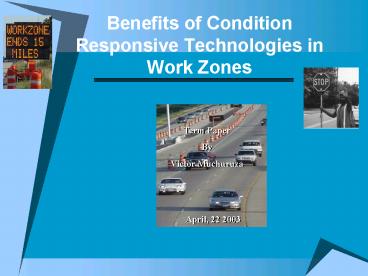Benefits of Condition Responsive Technologies in Work Zones - PowerPoint PPT Presentation
1 / 9
Title:
Benefits of Condition Responsive Technologies in Work Zones
Description:
... the safety of the work crew and those which warn and guide the motorists. Systems Which Warn the Work Crew. Intrusion Alarm Systems. Queue Detector Systems ... – PowerPoint PPT presentation
Number of Views:18
Avg rating:3.0/5.0
Title: Benefits of Condition Responsive Technologies in Work Zones
1
Benefits of Condition Responsive Technologies in
Work Zones
Term Paper By Victor Muchuruza
April, 22 2003
2
Problem
- The increase in traffic demand and reduced
capacity conditions at highway work zones - 1,079 casualties in 2001
- Studies show that 24 of non-recurring
congestion is from work zones - Delay and safety are intimately related
3
How can ITS technology Affect?
- Congestion management
- Incident management
- Real-time traffic data acquisition and dispersal
of pre-route and en-route traveler information - Variable Speed Limits
- Dynamic Lane Merge/No Passing Zones
- Automated Enforcement
- Moveable Barrier Technology
4
Condition Responsive Systems
- Action is automatically taken by the system when
certain conditions are met. - Use radar, microwave sensors and wireless
communications - Two Classesthose which ensure the safety of the
work crew and those which warn and guide the
motorists.
5
Systems Which Warn the Work Crew
- Intrusion Alarm Systems
- Queue Detector Systems
- Use Ultrasonic detectors, receiver and a
flashing buzzer
6
Condition Responsive Portable Changeable Message
Signs
- Adaptir system
- Advanced Portable Traffic Management System
(PTMS) - Condition-Responsive Work Zone Traffic Control
System, CRWZTCS - Travel Time Prediction System (TIPS) for Work
Zones - Portable Surveillance and Delay Advisory System
7
Potential Benefits
- Improved safety
- Improved mobility
- Reduce downtime(Get-in, Get-out,
- and Stay-out)
- Reduced enforcement
- Accurate/timely info to road users
- Cost savings
8
Conclusions and Recommendations
Following their deployments-
- High capacities at work zones increase of
accessibility and mobility - safety of both motorist and work personnel has
improved - Linkage with ATMC for dissemination of Traveler
Information
9
Conclusions and Recommendations
- Challenge- Uniformity/consistency































